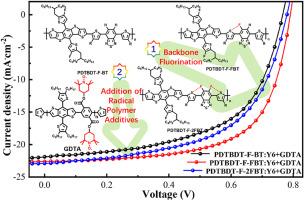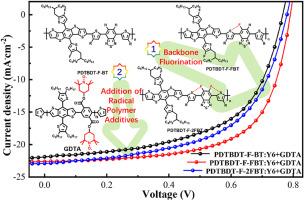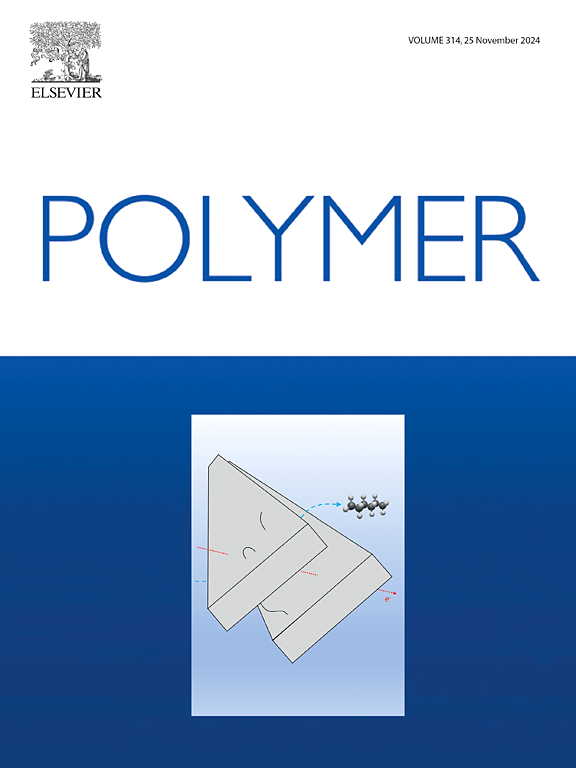Enhancing the photovoltaic performance of dithienobenzodithiophene based polymer donors through backbone fluorination and radical polymer additives
IF 4.1
2区 化学
Q2 POLYMER SCIENCE
引用次数: 0
Abstract
Unveiling the corresponding relationship between the molecular architecture of organic semiconductor materials and the morphology within the active layer of the organic solar cells (OSCs) is essential for the innovation of novel optical materials and the refinement of device optimization strategies to overcome the bottlenecks in efficiency. In this work, three dithieno[3,2-b]benzo[1,2-b;4,5-b’]dithiophene(DTBDT)-alt-benzothiadiazole (BT) based polymer donors (PDTBDT-F-BT, PDTBDT-F-FBT, and PDTBDT-F-2FBT) with varying fluorine atom content within their acceptor segments were designed and synthesized, and the photovoltaic performances of these polymers when blended with Y6 were meticulously investigated. Incorporating fluorine atoms into the BT segment was observed to not only incrementally increase the optical bandgap, lower the HOMO energy level, and bolster the self-aggregation of the polymer, but also effectively reduce the surface energy of the resulting polymer, thereby altering the donor-acceptor (D-A) interfacial spacing and the phase separation in the blend films as illustrated by molecular dynamic simulations and morphology characterization. As a result, the OSCs fabricated using PDTBDT-F-FBT, which incorporates a single fluorine substitution in the BT unit, demonstrated the highest power conversion efficiency (PCE) of 9.92 %. More importantly, this blend film's morphology is likely to be more conducive to the incorporation of the radical polymer additive, GDTA. This has resulted in a notable reduction in voltage loss, ultimately achieving a higher PCE of 11.55 % for the PDTBDT-F-FBT:Y6 based OSCs. This research uncovered a synergistic impact of backbone fluorination and the incorporation of radical polymer additives, which contributed to reducing the energy loss and enhancing the efficiency of OSCs from DTBDT-based polymer donors.


通过骨架氟化和自由基聚合物添加剂提高二噻吩基二苯并噻吩聚合物供体的光伏性能
揭示有机半导体材料的分子结构与有机太阳能电池(OSCs)活性层内部形态之间的相应关系,对于创新新型光学材料和完善器件优化策略以克服效率瓶颈至关重要。在这项工作中,我们设计并合成了三种二噻吩并[3,2-b]苯并[1,2-b;4,5-b']二噻吩(DTBDT)-卤代苯并噻二唑(BT)基聚合物供体(PDTBDT-F-BT、PDTBDT-F-FBT 和 PDTBDT-F-2FBT),并仔细研究了这些聚合物与 Y6 混合后的光伏性能。通过分子动力学模拟和形貌表征,观察到在 BT 段中加入氟原子不仅能逐步增加光带隙、降低 HOMO 能级并增强聚合物的自聚集,还能有效降低所得聚合物的表面能,从而改变供体-受体(D-A)界面间距以及共混薄膜中的相分离。因此,使用 PDTBDT-F-FBT 制作的 OSC(在 BT 单元中加入了单个氟替代物)显示出最高的功率转换效率(PCE),达到 9.92%。更重要的是,这种混合薄膜的形态可能更有利于加入自由基聚合物添加剂 GDTA。这显著降低了电压损耗,最终使基于 PDTBDT-F-FBT:Y6 的 OSC 的 PCE 达到 11.55%。这项研究揭示了骨架氟化和加入自由基聚合物添加剂的协同作用,这有助于降低能量损耗,提高基于 DTBDT 聚合物供体的 OSC 的效率。
本文章由计算机程序翻译,如有差异,请以英文原文为准。
求助全文
约1分钟内获得全文
求助全文
来源期刊

Polymer
化学-高分子科学
CiteScore
7.90
自引率
8.70%
发文量
959
审稿时长
32 days
期刊介绍:
Polymer is an interdisciplinary journal dedicated to publishing innovative and significant advances in Polymer Physics, Chemistry and Technology. We welcome submissions on polymer hybrids, nanocomposites, characterisation and self-assembly. Polymer also publishes work on the technological application of polymers in energy and optoelectronics.
The main scope is covered but not limited to the following core areas:
Polymer Materials
Nanocomposites and hybrid nanomaterials
Polymer blends, films, fibres, networks and porous materials
Physical Characterization
Characterisation, modelling and simulation* of molecular and materials properties in bulk, solution, and thin films
Polymer Engineering
Advanced multiscale processing methods
Polymer Synthesis, Modification and Self-assembly
Including designer polymer architectures, mechanisms and kinetics, and supramolecular polymerization
Technological Applications
Polymers for energy generation and storage
Polymer membranes for separation technology
Polymers for opto- and microelectronics.
 求助内容:
求助内容: 应助结果提醒方式:
应助结果提醒方式:


